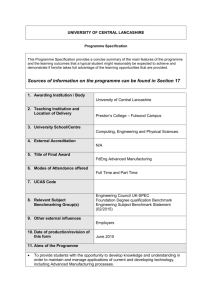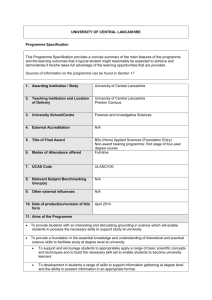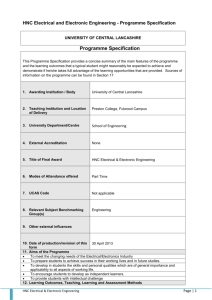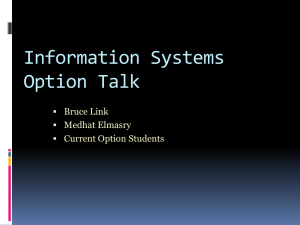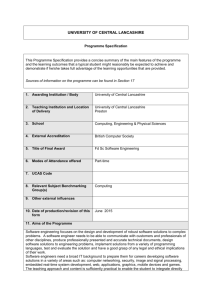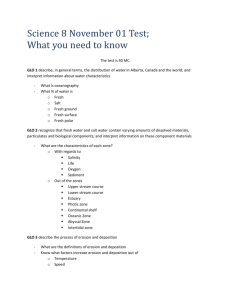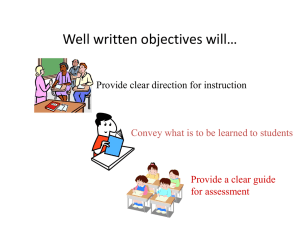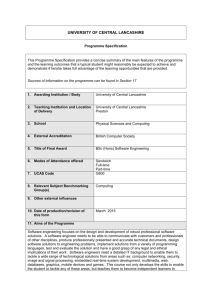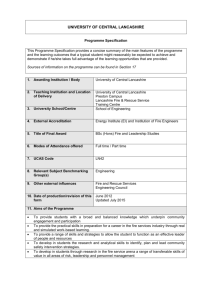fdeng_energy_and_power_engineering
advertisement
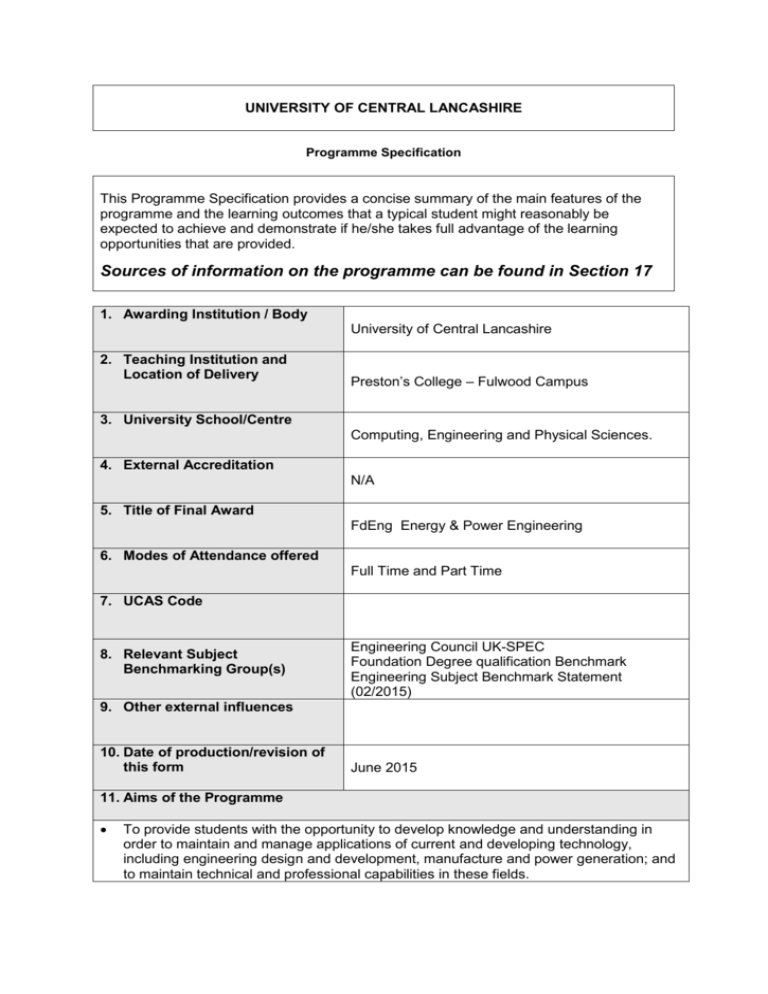
UNIVERSITY OF CENTRAL LANCASHIRE Programme Specification This Programme Specification provides a concise summary of the main features of the programme and the learning outcomes that a typical student might reasonably be expected to achieve and demonstrate if he/she takes full advantage of the learning opportunities that are provided. Sources of information on the programme can be found in Section 17 1. Awarding Institution / Body University of Central Lancashire 2. Teaching Institution and Location of Delivery Preston’s College – Fulwood Campus 3. University School/Centre Computing, Engineering and Physical Sciences. 4. External Accreditation N/A 5. Title of Final Award FdEng Energy & Power Engineering 6. Modes of Attendance offered Full Time and Part Time 7. UCAS Code 8. Relevant Subject Benchmarking Group(s) Engineering Council UK-SPEC Foundation Degree qualification Benchmark Engineering Subject Benchmark Statement (02/2015) 9. Other external influences 10. Date of production/revision of this form June 2015 11. Aims of the Programme To provide students with the opportunity to develop knowledge and understanding in order to maintain and manage applications of current and developing technology, including engineering design and development, manufacture and power generation; and to maintain technical and professional capabilities in these fields. To provide an extended, enhanced, and industrially relevant Foundation Degree programme of study in preparation for professional practice. To produce resourceful, competent, clear-thinking professional engineers with a range of skills and experience relevant to industry. To equip graduates of the programme with transferable knowledge, skills, experience, and understanding which underpin a range of Engineering careers. To develop in students the ability to apply their engineering knowledge and skills to the solution of theoretical and practical problems in Power Engineering. 12. Learning Outcomes, Teaching, Learning and Assessment Methods A. Knowledge and Understanding A1.Utilize a sound theoretical approach to enable the introduction and exploitation of new and advancing technology and other relevant developments, and related underpinning science and mathematics. (GLO: A1). A2: Describe the wider multidisciplinary engineering context and underlying principles A3: Describe and evaluate how management systems have evolved to meet global markets including current legal and quality issues. A4: Apply new theories, concepts, methods etc in unfamiliar situations. (GLO: A4). Teaching and Learning Methods Knowledge acquisition occurs initially through tutor-led lectures (teaching) and directed study of textbooks and journal articles. This is followed up by student led learning activity using text (books and e-resources), media (software, video, technical articles) and Active Enquiry research methods. The understanding of much engineering knowledge (learning) comes by application, use, and observation of effect. This is aided by tutorials, worked examples, analysis, synthesis, and Active Enquiry. Great benefit comes from this occurring in a group environment, where understanding can be developed by support from others. The tutor in these situations takes the role of a Mentor. The Teaching and Learning strategies employed deliver opportunities for the achievement of the learning outcomes, demonstrate their attainment and recognise the range of student backgrounds. Delivery methods, activities and tasks are aligned with the learning outcomes for this programme, taking account of the learning styles and stage of the student. Assessment methods Assessment of Knowledge is through examination of key facts using unseen papers. These include formal end of year examinations, focussing on a limited range of material during the year. Assessment of understanding of the knowledge (and knowledge itself if appropriate) is through assignment or other coursework including group projects as a major aspect of an engineering degree qualification. Assessment of practical application of knowledge in Project Based Learning and producing practical examples of methods and approaches to Engineering problem solving. Assessment is a measure against the benchmark criteria, and forms an important part of the learning process. B. Subject-specific skills B1: Practical Engineering competence acquired in laboratories; workshops; industry; individual & group project work, design work; and development & use of computer software. (GLO: B1, B2, B3). B2: Application of scientific, mathematical, and associated engineering principles necessary to underpin activities in Energy Engineering. (SLO: US1, US1m, US2, US2m, US3, US3m, US4m). B3: Creative use of engineering principles in problem solving, design, explanation and diagnosis relevant to Energy Engineering. (SLO: E1, E1m, E2, E2m, E3, E3m, E4). B4: Create and develop economically viable products, processes and systems to meet defined needs. (SLO: D1, D1m, D2, D3, D4, D4m, D5, D6). B5: Specify and develop energy engineering activities to promote sustainable development in an economic, social and environmental context. (SLO: S1, S1m, S2, S2m, S3, S4, S5). B6: Apply competence across professional engineering practice. (SLO: P1, P1m, P2, P2m, P3, P4, P5, P6, P7, P8, P8m). Teaching and Learning Methods The development of skills involves some tuition, some practice and considerable experience in using the skills in Engineering situations and relevant to engineering competencies. Skill development relates to areas specific to the Energy Engineering destinations of graduates and includes areas which are generic to engineering (such as workshop practices), those which are expected in an engineering degree, and those which are programme specific (such as entrepreneurial business skills). Development of team working within the engineering design context is a strong feature of the provision. The Placement activity is a significant aspect of the programme, both for the successful placement student and the culture of the final three years of the degree. Assessment methods The assessment methods include report writing, assignments, computational competencies and laboratory demonstrations. C. Thinking Skills C1: Apply appropriate quantitative science and engineering tools to the analysis of problems. (GLO: C1). C2: Demonstrate creative and innovative ability in the synthesis of solutions and in formulating designs. (GLO: C2). C3: Design and deliver engineering solutions with an appropriate level of detail. (GLO: C3). C4: Develop, monitor and update a plan, to reflect a changing operating environment. (GLO: C4). Teaching and Learning Methods The exercise and development of ‘Thinking Skills’ are achieved through active learning processes. Problem solving is the key to many engineering activities, and progresses in complexity and demand through the course. Staff interests and research often form the background to developments in active learning. Implementation of this is seen through the use of workshops, drawing/CAD facilities, dedicated software, laboratories, rapid / additive manufacture techniques, bureau manufacturing, student presentations, external visitors, and field/industry based activity. These learning processes compliment the more conventional seminars, tutorials and case study approaches found in HE. There is extensive group, and later team, working as a natural part of the working (and learning) environment in engineering. Assessment methods Assessment of thinking skills is by reports on practical investigations and tests, a ‘design and make’ project, case studies, formal examinations, workbooks and drawings in early stages of the course provision. In later stages, formal reports with reflection on practical activities; design and manufacture processes and results; generating and analysing CAD, and other simulation models; computer software based analysis and calculations; and evaluation of prototypes are included. The independent final Project and group project based assessments demonstrate capability in skills related to individual specialised knowledge, understanding and practical aspects. Unseen examinations are appropriate for assessment of some intellectual skills under time constrained conditions. Intellectual skills related to practical skills are tested through the experience of the activity in an appropriate context. These include the Engineering workshops and laboratory equipment, practical manufacture of prototypes during modules, the final Project, Creation and Evaluation. Workbooks and guidance manuals are used widely in earlier years. The optional Placement provides additional opportunities for the students choosing to take it. D. Other skills relevant to employability and personal development D1: Apply transferable skills that will be of value in a wide range of situations, including Problem solving; Communication; and Working with others. (GLO: D1). D2: Effective use of general IT [information technology] facilities and information retrieval skills. (GLO: D2). D3: Plan self-learning and improve performance, as the foundation for lifelong learning/CPD [continuing professional development]. (GLO: D3). D4: Monitor and adjust a personal programme of work on an ongoing basis, and to learn independently. (GLO: D4). Teaching and Learning Methods The Induction for the course starts the Personal Development Planning (PDP) programme, which is seen to continue after graduation as Continuing Professional Development (CPD). Communication, team working, engineering problem solving and design, reflective use of available software, planning, critical evaluation, verification of results, confidence in outcomes, inter-personal skills, emotional intelligence, and goal setting all feature and are emphasised at various points through the programme. The College Personal Tutor system is a useful vehicle for discussion of these aspects of personal development. However, much is learnt in the day to day interactions with staff, industry visitors, and other students. Assessment methods Written communication skills are developed and assessed through the context for the assessment. Examples include the requirements for a formal report, laboratory report, business or technical justification, reflective practice, critical evaluation in a commentary, or statement of confidence in a decision made in complex and unpredictable situations. Group based activity requires reflection on the performance of the individual within that context. Team based activities require an assessment of the team formation and contribution to the outcome. 13. Programme Structures* Level Level 5 Module Code PT2006 Module Title Engineering Design Credit rating 20 PT2009 Management in Industry 20 PT2021 PT2002 Project Analogue & Digital Electronics B Electromagnetic Systems 20 20 Work Based Study Computer Aided Draughting Electrical Principles 20 20 Mathematics for Technology Power Equipment 20 Electronics & Instrumentation Analogue & Digital Electronic A 20 EL2711 Level 4 14. Awards and Credits* MP2006 PT1005 PT1007 PT1014 PT1018 EL1715 PT1001 FdEng Energy & Power Engineering Requires a minimum of 240 credits including a minimum of 100 at Level 5. 20 20 FdCert Energy & Power Engineering Requires a minimum of 120 credits at Level 4. 20 20 * Delete rows not applicable to this Programme Specification 15. Personal Development Planning The course approach to Personal Development Planning (PDP) has been influenced by the LTSN Generic Centre Guide to Curriculum Design: Personal Development Planning. PDP activity is centred on: Reflection on learning, performance, and achievement. Planning for personal, educational, and career development. Students are invited to review and reflect on their academic study, extra-curricular activities and career planning. This results in an increased understanding and ownership of learning. Since learning is a lifelong process the work in PDP is not assessed. There are many similarities to work-based learning, and Continued Professional Development (CPD) - which is required for membership of professional societies. The skills in PDP are key components of employability: – self-reflection, recording, target setting, action planning and monitoring. Local web based materials relevant to PDP are found at: At Induction the student takes part in a session involving a range of self-assessment exercises. This is followed by early in Semester 1 the student being recommended to access the local web based materials, and other materials found by individual need or interest. The results of the activity or exercise are kept together in an A4 folder. This activity is reinforced for all first year students by encouraging communication and team working between students, and between students and staff. Subsequently during group tutorial sessions discussion is directed towards PDP elements. Any topics found difficult, or needing further work are discussed. Alternative approaches are considered and discussed. 16. Admissions criteria Programme Specifications include minimum entry requirements, including academic qualifications, together with appropriate experience and skills required for entry to study. These criteria may be expressed as a range rather than a specific grade. Amendments to entry requirements may have been made after these documents were published and you should consult the University’s website for the most up to date information. Students will be informed of their personal minimum entry criteria in their offer letter. Minimum 240- 280 UCAS points at A2 level or equivalent including Maths and/or a Science or engineering BTEC and GCSE Maths and English at Grade C or above. Applications from people with relevant work or life experience and/or non-standard qualifications are welcome and will be interviewed and assessed on an individual basis. 17. Key sources of information about the programme http://www.preston.ac.uk http://www.preston.ac.uk/courses/higher-education/engineering/ http://www.uclan.ac.uk/schools/computing_engineering_physical/engineering_courses.php http://www.uclan.ac.uk/information/courses/index.php 18. Curriculum Skills Map Please tick in the relevant boxes where individual Programme Learning Outcomes are being assessed Programme Learning Outcomes e.g. LEVEL 4 e.g. LEVEL 5 Module Level Code Module Title PT2006 Engineering Design PT2009 Management in Industry PT2021 Project EL2711 Electromagnetic Systems MP200 6 Work Based Study Computer Aided PT1005 Draughting PT1007 Electrical Principles Mathematics for PT1014 Technology PT1018 Power Equipment Electronics & EL1715 Instrumentation Analogue & Digital PT1001 Electronics A Analogue & Digital PT2002 Electronics B Core (C), Compulsory (COMP) or Option (O) Knowledge and understanding Subject-specific Skills A1 B1 B2 B3 A2 A3 COMP COMP COMP COMP COMP COMP COMP COMP COMP B4 B5 B6 C1 C2 C3 C4 D1 D2 COMP COMP COMP A4 Thinking Skills Other skills relevant to employability and personal development D3 Note: Mapping to other external frameworks, e.g. professional/statutory bodies, will be included within Student Course Handbooks D4 19. LEARNING OUTCOMES FOR EXIT AWARDS: For each exit award available, list learning outcomes relating to the knowledge and understanding, subject specific skills, thinking, other skills relevant to employability and personal development that a typical student might be expected to gain as a result of successfully completing each level of a course of study. For example, for a standard BA/BSc (Hons) award the exit award learning outcomes for CertHE (Level 4) and DipHE (Level 5), BA/BSc (Level 6) should be included; for a postgraduate Masters, this would normally be PGDip and PGCert. Learning outcomes for the award of: ________________ Learning outcomes for the award of: ________________ Updated April 2015 2
